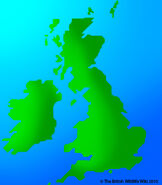The populations of Woodpigeons (Columba Palumbus) have increased so much that they are now regarded as a pest. Their success is due to intensive farming, leaving more food laying on the floor after them thus suplying a larger number of birds. In large numbers, they can destroy crops such a beans and turnips. It is not legal for people to kill them, as they are protected..

Wood Pigeon - Erik Paterson
The woodpigeons diet mainly consists of acorns, ivy berries and seeds. It nests on a platform of twigs, there are two eggs in each clutch. The chicks spend up to five weeks in the nest. Immature birds do not have the white neck patch
Distribution[]
In the colder northern and eastern parts of its Europe and western Asia range the Common Wood Pigeon is a migrant, but in southern and western Europe it is a well distributed and often abundant resident.
Description[]
The three Western European Columba pigeons, Common Wood Pigeon, Stock Pigeon, and Rock Pigeon, though superficially alike, have very distinctive characteristics; the Common Wood Pigeon may be identified at once by its larger size at 38–43 cm, and the white on its neck and wing. It is otherwise a basically grey bird, with a pinkish breast.
Juvenile birds do not have the white patches on either side of the neck. When they are about six months old (about three months out of the nest) they gain small white patches on both sides of the neck, which gradually enlarge until they are fully formed when the bird is about 6–8 months old (approx. ages only). Juvenile birds also have a greyer beak and an overall lighter grey appearance than adult birds.
Behaviour[]
Its flight is quick, performed by regular beats, with an occasional sharp flick of the wings, characteristic of pigeons in general. It takes off with a loud clattering. It perches well, and in its nuptial display walks along a horizontal branch with swelled neck, lowered wings, and fanned tail. During the display flight the bird climbs, the wings are smartly cracked like a whiplash, and the bird glides down on stiff wings. The noise in climbing flight is caused by the whipcracks on the downstroke rather than the wings striking together. The Common Wood Pigeon is gregarious, often forming very large flocks outside the breeding season.
Breeding[]
It breeds in trees in woods, parks and gardens, laying two white eggs in a simple stick nest which hatch after 17 to 19 days. Wood Pigeons seem to have a preference for trees near roadways and rivers. The nests are vulnerable to attack, particularly by crows, the more so early in the year when the leaf cover is not fully formed. The young usually fly at 33 to 34 days; however if the nest is disturbed some young may be able to survive having left the nest as early as 20 days from hatching.
Diet[]
Most of its diet is vegetable, taken from open fields or gardens and lawns; young shoots and seedlings are favoured, and it will take grain, as well as certain fruits and berries. This species can be an agricultural pest, and it is often shot, being a legal quarry species in most European countries. It is wary in rural areas, but often quite tame where it is not persecuted. Young Common Wood Pigeons swiftly become fat, as a result of the 'milk' they are fed by their parents. This is an extremely rich, sweet fluid that is produced in the adult birds' crop during the breeding season.
Disease[]
The Common Wood Pigeon is the most common pigeon in the United Kingdom, with numbers having doubled from 2008 to 2009. Although they are often seen as a pest, and their urine can cause damage to buildings, the health risks carried by these birds are minimal.
Similar Species: Stock Dove
Gallery[]
Videos[]
thumb|300px|right|Wood Pigeon by Erik Paterson



